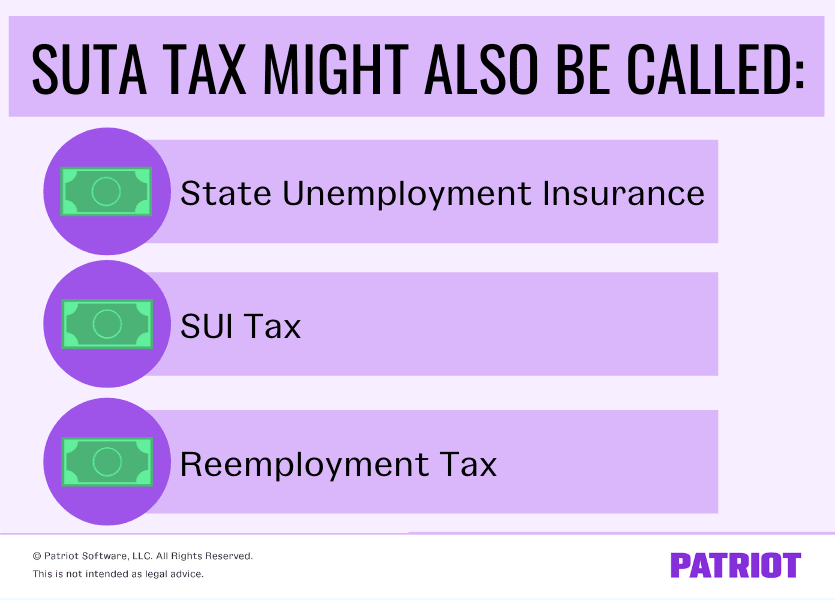When you become an employer, you add a lot of things to your plate, like running payroll. And, one of your employer responsibilities with payroll is withholding certain taxes, such as SUTA tax. But, what is SUTA tax?
SUTA Definition
The State Unemployment Tax Act (SUTA) tax is a type of payroll tax that states require employers to pay. SUTA was established to provide unemployment benefits to displaced workers. States use funds to pay out unemployment insurance benefits to unemployed workers.
States might also refer to SUTA tax as the following:
- State unemployment insurance
- SUI
- Reemployment tax (e.g., Florida)
Who pays SUTA tax? In most states, SUTA or SUI is an employer-only tax. However, employees in Alaska, New Jersey, and Pennsylvania must also pay SUI tax. If you have employees in any of these three states, withhold SUTA tax from their wages and remit it to the state.
Some states might exempt certain businesses from paying SUTA tax. For example, a state might exempt nonprofit organizations and businesses with few employees from paying state unemployment taxes.
There are a couple of key components of SUTA tax that you should be aware of, including the SUTA wage base and rates.

SUTA wage base
Each state sets its own SUTA tax wage base. A taxable wage base, or threshold, is the maximum amount of an employee’s income that can be taxed.
The SUTA wage base is the same for all employers in the state. For example, the wage base for Washington state employers is $52,700 for 2020. This means all Washington employers that are not exempt from withholding SUTA tax must pay the tax on an employee’s wages until they earn this amount.
Each state’s wage base is subject to change each year. Stay up-to-date with your SUTA wage base to ensure you’re withholding the correct amount of SUTA tax for each employee.
SUTA rates
Like SUTA wage bases, SUTA rates also vary state to state. Each state typically has a range of SUTA rates (e.g., 0.65% – 6.8% in Alabama). When you register as an employer, your state will generally tell you what your SUTA tax rate is.
Many states give new employers a standard new employer SUTA rate. The new employer SUI rate is different in each state. Once you gain more experience as an employer, your state will assign you a new rate.
States might also base rates on your industry, like construction and non-construction industries. Construction industries typically have a higher SUTA rate than non-construction industries.
For example, the Ohio new employer SUTA rate for 2019 is 2.7%. But, the new construction employer rate is 5.9% for 2019.
If you live in a state that doesn’t assign a standard new employer rate, you need to wait for your state to assign yours.
If you’re a new employer, follow the steps below to find out your SUTA rate:
- Sign up for a SUTA tax account with your state
- Receive new employer contribution rate from the state
- Get updated SUTA rate from your state
SUTA tax example
Say you’re a new employer in Kentucky. You run a non-construction business. The new employer rate in Kentucky for 2019 is 2.7%. Kentucky’s SUTA wage base for 2019 is $10,500. This means you must pay up to $283.50 in SUTA taxes per employee (e.g., .027 x $10,500).
On the other hand, say you’re an employer in the construction industry in Kentucky. Your new employer rate would be 9.75% instead of 2.7% for 2019. You could pay up to $1,023.75 in SUTA taxes per employee with your new employer construction rate (.0975 x $10,500).
How to apply for a SUTA account
Are you a new employer? Yes? Great (and congrats!). It’s time for employer registration.
So… how do you do that?
To get started applying for your state unemployment tax account, you must check your state’s website for details.
Each state’s signup process varies. In most cases, you can apply online directly through your state’s website. Check out new employer information by state for more details. You can also consult your state for more information about how to apply for a SUTA account.
Paying SUTA tax to your state
You’re responsible for reporting your SUTA tax liability to your state and making payments. In most cases, you will need to make quarterly SUTA payments to your state.
Fill out your state’s return that reports employee wages to the state unemployment tax office. You may need additional information to fill out this return, such as your employees’ SOC codes.
Many states give employers an option to file and pay their state unemployment taxes online. Check with your state about whether or not you can pay your SUTA tax liability electronically. And, be sure to contact your state for more details about depositing and reporting your SUTA tax liabilities.
Looking for an efficient way to track your SUTA tax liabilities? Patriot’s Full Service payroll services will do all the SUTA tax legwork for you by collecting, filing, and remitting all of your payroll taxes. Get started with your free trial today!
Want to inspire our next article? Connect with us on Facebook and let us know your ideas or the questions you want answered!
This article has been updated from its original publication date of March 17, 2015.
This is not intended as legal advice; for more information, please click here.



